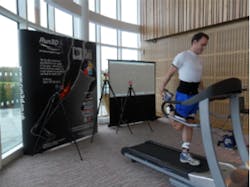3-D motion analysis helps prevent injuries
A spin-out fromOxford University (Oxford, UK) called Run3D (Oxford, UK) is using a 3-D motion analysis system to help identify abnormal patterns in a runner's gait to prevent overuse injuries.
The system -- which was developed by Professor Reed Ferber at the Running Injury Clinic at the University of Calgary -- uses multiple infrared cameras to measure the angles of runner's joints in three planes. The results are then compared to a biomechanical database to identify any abnormal patterns in the runner's gait to improve performance and prevent injury.
A full assessment takes two hours and is backed by advice from a team headed by Dr. Jessica Leitch, CEO of Run3D. Dr Leitch began working on the service after completing her doctoral studies in running injury biomechanics at Oxford University's Department of Engineering.
"An accurate analysis of a runner’s biomechanics is fundamental to understanding the root-cause of a musculoskeletal overuse injury and to delivering a long-term solution to optimal running. Conventional video based systems are subjective and not sensitive enough to detect the subtle abnormalities that can lead to injury," says Dr. Leitch.
The spin-out is being funded by an initial investment from a new fund managed by Oxford Technology Management. The Oxford Technology Combined Seed Enterprise Investment and Enterprise Investment Scheme Fund (OT(S)EIS) targets start-up technology companies near Oxford.
Related items on motion analysis from Vision Systems Design.
1.Multicamera system performs motion analysis
Analyzing human movement from image data has many applications ranging from motion picture production to medical analysis.
2.Imaging system captures pianist movements for analysis
Academics at the University of Southampton (Southampton, UK) are using motion capture technology to examine the way pianists play the piano.
-- Dave Wilson, Senior Editor,Vision Systems Design
